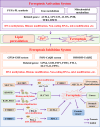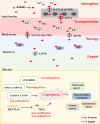Epigenetic regulation of diverse cell death modalities in cancer: a focus on pyroptosis, ferroptosis, cuproptosis, and disulfidptosis
- PMID: 38654314
- PMCID: PMC11040947
- DOI: 10.1186/s13045-024-01545-6
Epigenetic regulation of diverse cell death modalities in cancer: a focus on pyroptosis, ferroptosis, cuproptosis, and disulfidptosis
Abstract
Tumor is a local tissue hyperplasia resulted from cancerous transformation of normal cells under the action of various physical, chemical and biological factors. The exploration of tumorigenesis mechanism is crucial for early prevention and treatment of tumors. Epigenetic modification is a common and important modification in cells, including DNA methylation, histone modification, non-coding RNA modification and m6A modification. The normal mode of cell death is programmed by cell death-related genes; however, recent researches have revealed some new modes of cell death, including pyroptosis, ferroptosis, cuproptosis and disulfidptosis. Epigenetic regulation of various cell deaths is mainly involved in the regulation of key cell death proteins and affects cell death by up-regulating or down-regulating the expression levels of key proteins. This study aims to investigate the mechanism of epigenetic modifications regulating pyroptosis, ferroptosis, cuproptosis and disulfidptosis of tumor cells, explore possible triggering factors in tumor development from a microscopic point of view, and provide potential targets for tumor therapy and new perspective for the development of antitumor drugs or combination therapies.
Keywords: Cuproptosis; Disulfidptosis; Epigenetic modification; Ferroptosis; Pyroptosis.
© 2024. The Author(s).
Conflict of interest statement
The authors declare no competing interests.
Figures






References
Publication types
MeSH terms
Grants and funding
LinkOut - more resources
Full Text Sources
Medical

